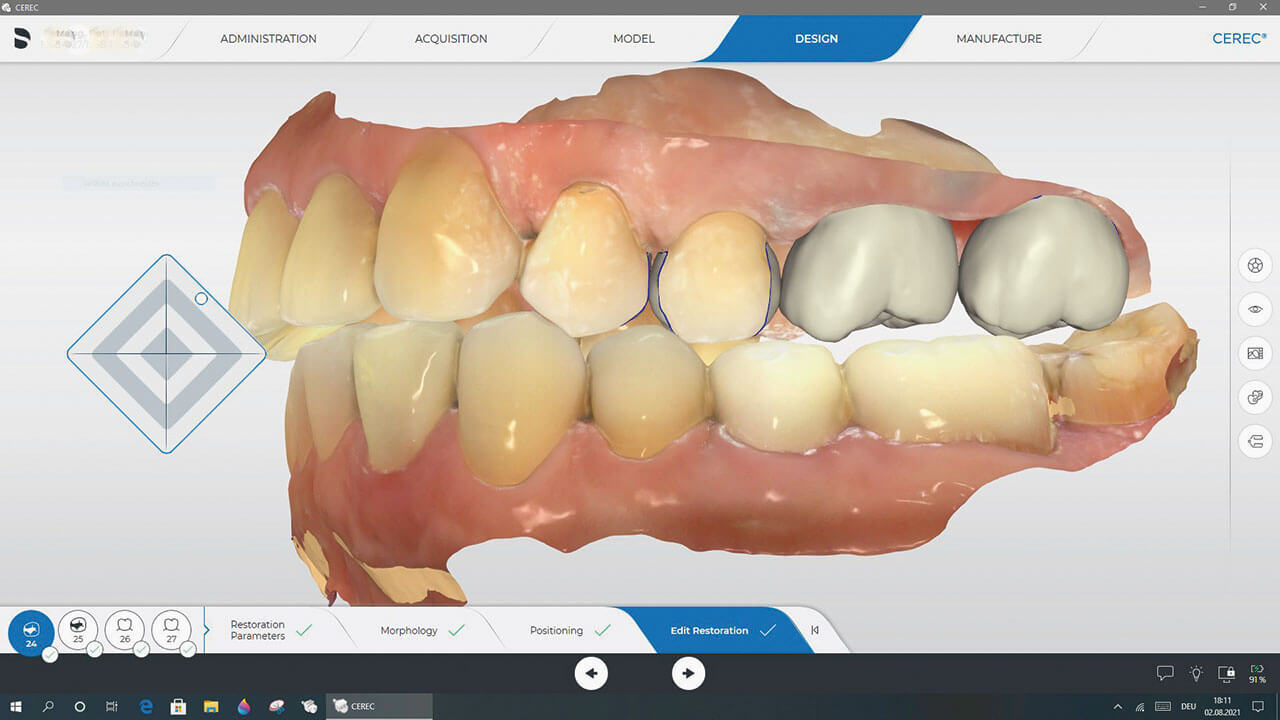The International Journal of Prosthodontics, 1/2023
DOI: 10.11607/ijp.7287, PubMed-ID: 33751004Seiten: 7-12, Sprache: EnglischPala, Kevser / Bindl, Andreas / Mühlemann, Sven / Özcan, Mutlu / Hüsler, Jürg / Ioannidis, AlexisPurpose: To evaluate the minimum ceramic thickness needed to increase the lightness by one value by means of glass-ceramic restorations, as perceived by dental technicians, dentists, and laypersons.
Materials and Methods: A total of 15 assessment pairs (= reference and test sample) were formed using glass-ceramic blocks in four different colors. Each assessment pair was comprised of two underground blocks differing by one value of lightness. On top of the underground blocks, glass-ceramic platelets were cemented in 5 different thicknesses (0.1 to 0.5 mm) in the same color as the reference. Dental technicians, dentists, and laypersons (n = 41/group) were asked to determine the presence of a color difference between the two samples under standardized light conditions. The threshold ceramic thickness was defined as the thickness at which ≥ 50% of the evaluators were not able to perceive a difference within an assessment pair. The thresholds were analyzed, and groups were compared by applying chi-square test (P < .05).
Results: The majority of dentists and dental technicians (> 50%) detected a lightness difference between test and reference samples up to a ceramic thickness of 0.5 mm. The majority of laypersons (≥ 50%) did not perceive lightness differences with ceramic thicknesses of 0.5 mm. If separated by the different color changes, the threshold ceramic thickness started at 0.4 mm and varied within the groups of evaluators and the lightness of the assessed color.
Conclusions: A considerable number of evaluators perceived a lightness difference when minimally invasive ceramic restorations of 0.5-mm thickness were applied. The threshold ceramic thickness, however, was reduced when the lightness of the substrate was lower.
International Journal of Computerized Dentistry, 4/2021
ApplicationPubMed-ID: 34931778Seiten: 429-438, Sprache: Englisch, DeutschBindl, AndreasDurch die deutlich schnellere Fertigungstechnik von chairside gefertigten Restaurationen mithilfe der Primemill Schleifeinheit, ist es möglich, die Sanierung eines gesamten Quadranten in angemessener Zeit vorzunehmen. Bei dem beschriebenen Procedere war zudem möglich, eine neuartige mittelfeste Keramik einzusetzen und insgesamt ein sehr gutes ästhetisches Resultat zu erzielen.
Schlagwörter: Cerec CAD/CAM Chairside, Inlays, Kronen, CAD/CAM Chairside Materialien
International Journal of Computerized Dentistry, 2/2017
PubMed-ID: 28630954Seiten: 119-120, Sprache: Englisch, DeutschBindl, AndreasInternational Journal of Computerized Dentistry, 4/2015
PubMed-ID: 26734666Seiten: 319-331, Sprache: Englisch, DeutschMaggetti, Ivano / Bindl, Andreas / Mehl, AlbertStudienziele: Welche Indikationen eine Mittelwertartikulation abdecken kann, beziehungsweise in welchem Ausmaß individuelle Registrierungen (insbesondere per Gesichtsbogen) gefordert sind, kann nur ermittelt werden, indem man die Variabilität bestimmter anatomischer Referenzpunkte untersucht. Gegenstand dieser Studie war die Ermittlung von Durchschnittswerten und anatomischen Bandbreiten von Kiefergelenkspositionen.
Material und Methode: Aus einer umfangreichen Datenbank von DVT-Aufnahmen wurden willkürlich anonymisiert Datensätze von 120 Patienten ausgewählt, 3-D-Daten generiert und einschlägige Referenzpunkte auf ihnen vermessen sowie die Bandbreiten und Mittelwerte der anatomischen Lagebeziehungen errechnet.
Ergebnisse: Das Bonwill-Dreieck zeigte eine mittlere Schenkellänge von 103,3 mm (90,2 bis 117,9 mm) und eine Basislänge von 99,6 mm (85,2 bis 112,6 mm). Es fand sich eine enge Korrelation zwischen den linken und rechten Schenkellängen, nicht aber zwischen den Schenkel‑ und den Basislängen. Die mittlere Kondylenhöhe des Bonwill-Dreiecks lag bei 34,3 mm (21,0 bis 47,2 mm) posüber der Okklusionsebene. Der Balkwill-Winkel betrug im Mittel 20,4° (9,0° bis 27,6°), der Winkel zwischen Camper- Ebene und Okklusionsebene rund 7°.
Schlussfolgerung: Diese Studie gibt Aufschluss über die Bandbreite der für Artikulationssysteme benötigten anatomischen Lagebeziehungen. Die Resultate wurden geschlechterspezifisch erhoben. Die relevanten Parameter offenbarten im Seitenvergleich ein hohes Maß an Symmetrie. Das Bonwill-Dreieck ist mit sehr hoher Wahrscheinlichkeit eher gleichschenkelig als gleichseitig.
Klinische Signifikanz: Kennt man die anatomische Bandbreite der Kiefergelenkspositionen relativ zur Bezahnung, so eröffnen sich Möglichkeiten für Simulationen mit softwaregesteuerten virtuellen Artikulatoren. Die Anwendung eines Gesichtsbogens könnte sich dann erübrigen.
Schlagwörter: Bonwill-Dreieck, anatomische Referenzpunkte, Camper-Ebene, Artikulator, Okklusionsebene
International Journal of Computerized Dentistry, 2/2015
PubMed-ID: 26110928Seiten: 163-175, Sprache: Englisch, DeutschBindl, AndreasEs ist jetzt möglich, mit Cerec Guide 2 (Sirona, Bensheim) volldigitale Bohrschablonen relativ schnell, rationell und kostengünstig in der Zahnarztpraxis herzustellen. Das Vorgehen und die Methode werden beispielhaft anhand einer Kasuistik beschrieben. Im Vergleich zu anderen derzeit auf dem Markt angebotenen Systemen bietet die hier vorgestellte Lösung den Vorteil rationeller Abläufe, ohne die externe Herstellung der Bohrschablone im Labor oder in einem Fertigungszentrum in Anspruch zu nehmen.
Schlagwörter: Cerec CAD/CAM-Chairside, digitale Volumentomographie, Implantatplanung, prothetische Planung, Bohrschablonen
Quintessence International, 2/2015
DOI: 10.3290/j.qi.a32634, PubMed-ID: 25191670Seiten: 97-108, Sprache: EnglischSchmidlin, Patrick R. / Stawarczyk, Bogna / DeAbreu, Danielle / Bindl, Andreas / Ender, Andreas / Ichim, Ionut P.Objective: To evaluate the fracture resistance and failure types of modified H-designed intradental short retention preparation for computer-aided design/computer-assisted manufacture (CAD/CAM) restorations, in cases where no ferrule is possible.
Method and Materials: A combined finite element analysis and in vitro testing was employed. Forty extracted single-rooted premolars were selected and prepared for the following four groups (n = 10 per group): Group A, H-post preparation restored with glass-ceramic crowns; group B, H-post preparation restored with lithium disilicate crowns; group C, endocrowns (negative control group); and group D, 2-mm ferrule preparation and restoration with fiber posts (positive control). After cementation, specimens were loaded to fracture (1 mm/min) in a universal testing machine. The data were analyzed using Kolmogorov-Smirnov, Shapiro-Wilk test, one-way ANOVA, followed by post-hoc Scheffé test and chisquare test.
Results: The H-post group restored with lithium disilicate crowns (group B) presented higher fracture resistance compared to the H-post group with glass-ceramic crowns (group A) and the endocrowns (group C). Among the failure analysis, only specimens of group C were all repairable after fracture load test, while the specimens of remaining groups A, B, and D accounted for 90%, 70%, and 50% repairable fracture modes, respectively.
Conclusion: The modification of the short intracoronal restoration anchorage profile may be a valid concept to improve the retention and fracture resistance, given that the materials are adjusted for this purpose in terms of mechanical resistance and internal adaptation. Numerical evaluations and future in vitro studies may help to select the best designs and materials.
Schlagwörter: bonding, CAD/CAM, ceramic, failure types, finite element analysis, fracture resistance
Quintessence International, 10/2015
DOI: 10.3290/j.qi.a34701, PubMed-ID: 26345100Seiten: 871-880, Sprache: EnglischGrohmann, Philipp / Bindl, Andreas / Hämmerle, Christoph / Mehl, Albert / Sailer, IrenaObjective: The aim of this multicenter randomized controlled clinical trial was to test posterior zirconia-ceramic fixed dental prostheses (FDPs) veneered with a computer-aided design/computer- assisted manufacture (CAD/CAM) lithium disilicate veneering ceramic (CAD-on) and manually layered zirconia veneering ceramic with respect to survival of the FDPs, and technical and biologic outcomes.
Method and Materials: Sixty patients in need of one posterior three-unit FDP were included. The zirconia frameworks were produced with a CAD/CAM system (Cerec inLab 3D/Cerec inEOS inLab). Thirty FDPs were veneered with a CAD/CAM lithium disilicate veneering ceramic (Cad-on) (test) and 30 were veneered with a layered zirconia veneering ceramic (control). For the clinical evaluation at baseline, 6, and 12 months, the United States Public Health Service (USPHS) criteria were used. The biologic outcome was judged by comparing the plaque control record (PCR), bleeding on probing (BOP), and probing pocket depth (PPD). Data were statistically analyzed.
Results: Fifty-six patients were examined at a mean follow-up of 13.9 months. At the 1-year follow-up the survival rate was 100% in the test and in the control group. No significant differences of the technical outcomes occurred. Major chipping occurred in the control group (n = 3) and predominantly minor chipping in the test group (minor n = 2, major n = 1). No biologic problems or differences were found.
Conclusions: Both types of zirconia-ceramic FDPs exhibited very good clinical outcomes without differences between groups. Chipping occurred in both types of FDPs at small amounts, yet the extension of the chippings differed. The test FDPs predominantly exhibited minor chipping, the control FDPs major chipping.
Schlagwörter: CAD/CAM, CAD-on, fixed dental prosthesis, lithium disilicate, zirconia
International Journal of Computerized Dentistry, 2/2014
PubMed-ID: 25098157Seiten: 95-96, Sprache: Englisch, DeutschBindl, AndreasInternational Journal of Computerized Dentistry, 2/2014
PubMed-ID: 25098159Seiten: 115-124, Sprache: Englisch, DeutschRitter, Lutz / Palmer, J. / Bindl, Andreas / Irsen, Stefan / Cizek, Jirka / Karapetian, Viktor-E. / Zöller, Joachim E.In dieser Studie beschreiben die Autoren ein experimentelles Verfahren zu chairside gefertigten Bohrschablonen, die ausschließlich auf digitalen Daten basieren. Darüber hinaus wird eine erste Evaluation der In-vitro-Genauigkeit dieser Schablonen auf Gipsmodellen präsentiert. Materialien und Methoden: Es wurden 24 Implantate nach dem neuen Verfahren, das auf Registrierung der DVT- und CAD/CAM-Daten basiert, geplant und anschließend die Pilotbohrungen durchgeführt. Um die virtuelle Planung in die Realität zu übertragen, wurden aus einem Stück chairside Bohrschablonen gefräst. Anschließend erfolgte die Eruierung der Messgenauigkeit.
Ergebnisse: Die Erstellung der chairside gefrästen Bohrschablonen war erfolgreich und die Genauigkeit der Pilotbohrung lag zwischen 0,17 und 1,3 mm. Fazit: Im Rahmen dieser experimentellen Studie konnten die Autoren feststellen, dass die chairside vorgenommene Herstellung von Bohrschablonen möglich ist. Sie erfordert keine Vorbereitungen vor dem DVT-Scan.
Schlagwörter: Genauigkeit, dentale Implantologie, digitale Volumentomographie (DVT), dentale CAD/CAM, computerassistierte Chirurgie, Bohrschablone, chirurgische Bohrschablone
The International Journal of Prosthodontics, 2/2014
DOI: 10.11607/ijp.3514, PubMed-ID: 24596916Seiten: 165-168, Sprache: EnglischRonay, Valerie / Bindl, Andreas / Sahrmann, Philipp / Schmidlin, Patrick R.Purpose: To describe the survival, clinical rating, and patient satisfaction of monolithic computer-aided design/computer-assisted manufacture (CAD/CAM) ceramic singleunit cantilever crowns placed on hemisected molars and premolars after a follow-up of at least 12 months.
Materials and Methods: Sixteen consecutive patients (mean age, 56.8 years) with 16 restored two-unit cantilever crowns (5 premolars and 11 hemisected molar abutments) were reevaluated after an observation period of at least 12 months. Tooth mobility, plaque and bleeding scores, and pocket probing depths were assessed on both the restored and contralateral untreated teeth. Patient satisfaction was evaluated using a visual analog scale.
Results: The mean observation time was 25.7 ± 13.1 months. All restorations were in situ, and no significant biologic differences were observed between the treated and contralateral teeth. Clinical evaluation showed good performance, and patient satisfaction was recorded as excellent.
Conclusion: The use of CAD/CAM ceramic single-unit cantilever crowns may be regarded as a conservative and cost-effective treatment modality with high patient acceptance in carefully selected patients. Int J Prosthodont 2014;27:165-168. doi: 10.11607/ijp.3514







